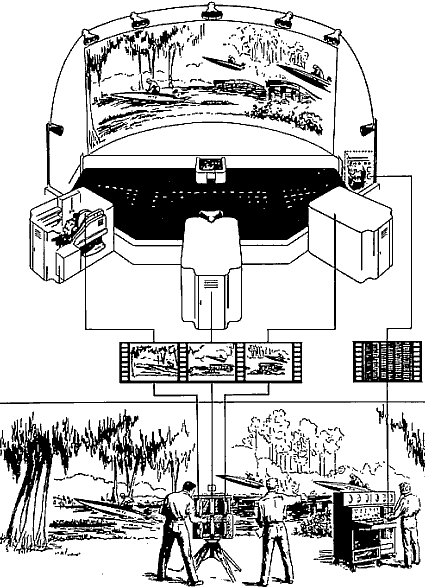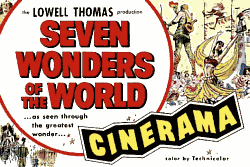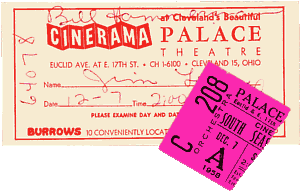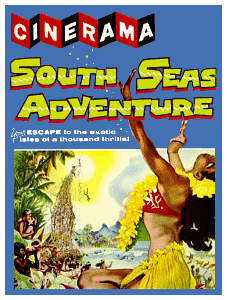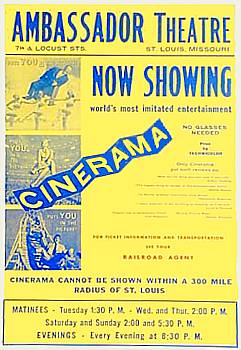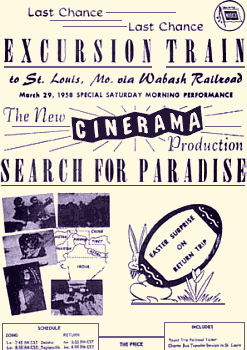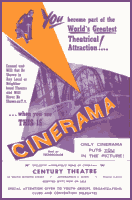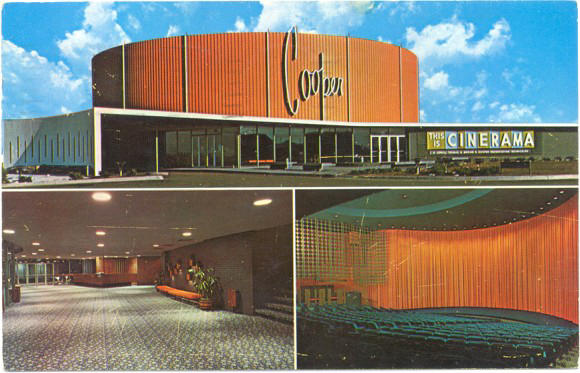|
|
|
|
|
|
|
|
|
|
|
|
|
|
|
|
|
|
|
|
|
|
|
|
|
|
|
|
|
|
Illustration of a CINERAMA theatre and production filming. Unlike today's films, Cinerama frequently recorded six or more channels of sound live.
Installation of Cinerama in 1952 cost between $25,000 and $75,000 depending on the theatre. It was felt that eventually Cinerama would be able to operate with a single projector, operating much as the triple lensed camera. A bit too optimistically, Cinerama executives said that this would allow their system to be run even in small town theatres. A single film version was not envisioned. Within a year they had changed their story and admitted that small town theatres were out of the question, probably because the exclusive roadshow treatment was paying off handsomely.
Read about the installation and running of
Cinerama in Detroit's Music Hall Theatre in 1953.
NEW!
Cinerama Recording of Live Sound Effects for
How The West Was Won
Lowell Thomas photographed while filming the prologue to his second Cinerama production, Seven Wonders of the World. Thomas is pointing to the photo of Cinerama inventor Fred Waller, (seen at the top of the previous page). Looming over Thomas is a portrait of T.E. Lawrence, whom Thomas had made famous throughout the world as "Lawrence of Arabia" while he was a war correspondent in World War I. Thomas always felt that the story of Lawrence would have been a good subject for the Cinerama cameras, as the broad vistas photographed by Freddie Young in David Lean's interpretation of the Lawrence story attest.
The office set appears to be the same one used in the prologue of This Is Cinerama. Due to the Cinerama camera's tendency to exaggerate distance, interior sets were made rather small so that they didn't appear to be ballrooms on the screen.
The Famous "Gigolo", (spellings vary, this is the way it appears in This Is Cinerama promotional materials). This device was located in the gate of each of the three projectors and, operating from a cam, moved tiny comb-like teeth up and down at a high speed to slightly blur and vignette the edges of each panel to create a smoother blend of the seams.
Click the little poster to see an ad for the world premiere of South Seas Adventure
Not just This Is Cinerama, but every Cinerama film was considered, and treated as, an event. The full roadshow hard ticket policy was normal. Seen at left, the envelope that delivered reserved seat tickets to the December 7, 1958 matinee of Cinerama South Seas Adventure at the Palace Cinerama in Cleveland, Ohio.
Paradise wasn't found in Search For Paradise but this shot of producer Carl Dudley and the Cinerama camera admiring Ramine, famous Polynesian dancer, might be evidence that Paradise was found in South Seas Adventure. Director of Photography John F. Warren, A.S.C. peers through the viewfinder. The man behind producer Dudley is unidentified.
The Ambassador Theatre - St. Louis, Missouri. One of the first giant movie palaces to convert to Cinerama. The nearest city running This Is Cinerama was Chicago. Ads of this type were circulated great distances from St. Louis, the ad on the left coming from Kansas City, which had not installed Cinerama at that point. Note that ticket and travel information could be obtained from a Railroad Agent! Seen above right is an ad for a train run specifically scheduled for Cinerama. What was that Easter Surprise? - Rabbit Stew? St. Louis theatres had promoted roadshow films over great distances for a number of years, for instance, Loew's State had done so with MGM's Show Boat and Quo Vadis. Did the public travel such long distances just to see a movie? Ask the thousands who have literally travelled around the world to see Cinerama in Dayton, Ohio, Bradford, England, or John Mitchell's back yard in Australia.
Ticket Order Flyer for
Century Cinerama Theatre,
Minneapolis, Minnesota
Special order form for
Century Theatre,
Minneapolis, Minnesota
THIS IS SUPER CINERAMA. Not a new photographic process as stated by one so-called "expert", but a theatre designed from the ground up to show 3-strip Cinerama films. Cooper Theatres built the first Super Cinerama in Denver, Colorado in 1962. The image above is a postcard from the Minneapolis Cooper.
(Courtesy of Jeff Johnson)
Up through approximately 1960, all Cinerama installations were conversions of existing theatres. Beginning with the Cooper Cinerama in Denver, Colorado, new theatres were built specifically for presentation of the unique process. These were the SUPER CINERAMA theatres that featured an enormous screen filling the entire front wall, floor to ceiling, and the projection booths were built into the rear and side walls of the theatre. The screen itself was unusual not only in its size and shape, it was composed of hundreds of vertical strips about 3/4 inch wide. These strips were all oriented to reflect light toward the back of the theatre so that the bright image would not be washed out by cross reflections from each screen side to the other. Due to the extreme screen curvature, the five channels of sound originating from behind the screen had a sonic peripheral effect as impressive as the visual. The "sweet spot" for viewing Cinerama was at the crossover point of the three projection beams. At this point the viewer's field of vision was nearly filled and the directional stereophonic sound extended the realism of the image. The auditorium contained speakers located on the side walls and rear of the theatre. Sound tracks six and seven were controlled by the Cinerama theatre engineer who would pan those channels manually to enhance the sonic effect. In addition to that, the Cinerama engineer also monitored the picture brightness and framing, sending directions to the individual Able, Baker, and Charlie projection booths. Over a dozen technicians were required to run the early Cinerama showings but the crew came down to a maximum of six as the system was refinded. The crew consisted of three projectionists operating the Able, Baker, and Charlie projectors, an operator in charge of the sound dubber, a control engineer that monitored the show and directed the four operators to make adjustments as necessary though the system had become rugged enough that minimal adjustments were required once the show was up and running.
Shown at left is the ticket order form for How The West Was Won at the Martin Cinerama Theatre in St. Louis, Missouri. The Martin was one of the largest of the Super Cinerama Theatres with a screen arc length of 96 feet. The Martin/Trans-Lux building was demolished in late September, 1997.
Interior of the Martin Cinerama in Seattle, Washington as it appeared in 1963. This theatre, now renovated by gazillionaire Microsoft co-founder Paul Allen, was a slightly smaller version of its sister theatres in St. Louis and New Orleans, the biggest in the chain.
For those youngsters that have only viewed films from crackerbox auditoriums in multiplexes, those rippled things in the photo are called curtains, and there's a really, really big screen behind the ones at the front of the theatre.
You are on Page 2 of
E-mail the author
CLICK HERE©1996 - 2010 The American WideScreen Museum
http://www.widescreenmuseum.com
Martin Hart, Curator
